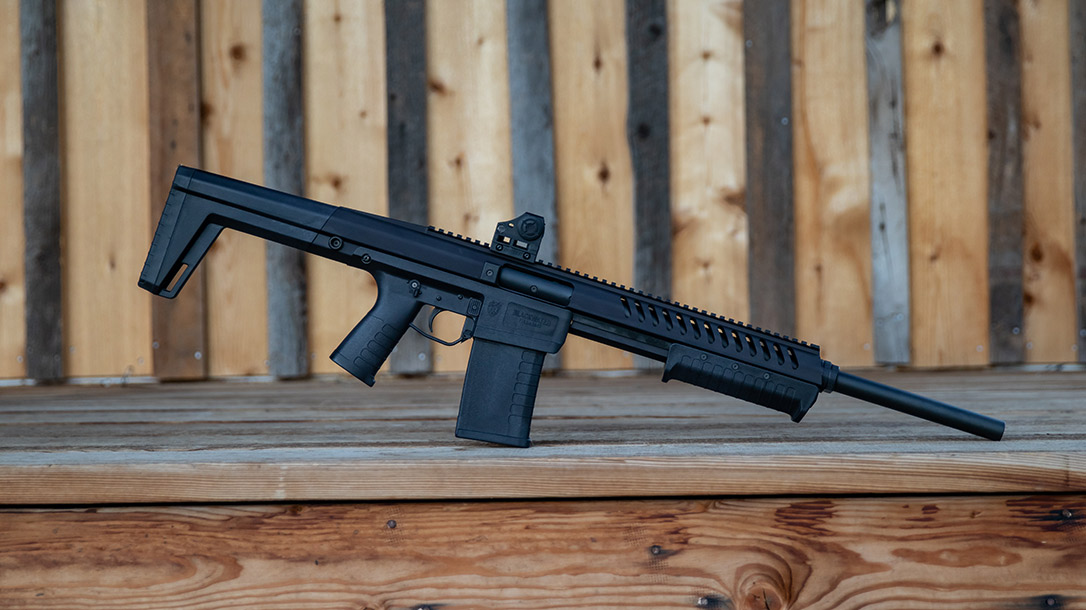A home-defense shotgun needs to be a few things. It needs to be compact enough to maneuver through a home or apartment; it should be easy to use so that everyone in the household can use it in the worst of circumstances; and it must be utterly reliable. I would add that a defensive shotgun should also be easy to load and reload. But, until recently, quickly loading a tube magazine depended on the gun’s design and plenty of practice. The Iron Horse Sentry 12 shotgun exemplifies new, faster loading methods.
The Iron Horse Sentry 12 Shotgun—Something New
Let’s be honest about a few things. The pump guns most selected for home defense—Remington 870s, Mossberg 500s/590s and the like— can be outfitted with components optimized for defensive use. However, these decades old shotgun designs use traditional stocks. An added pistol grip works but sits pretty far back, placing the weight forward of the shooting hand. This poorly distributed weight makes the gun really font-heavy. Add an extended magazine tube, some kind of optic, rails and accessories, and that’s a lot of weight up front. Not to mention it usually has an extremely light buttstock that does nothing to help balance things out. It’s time for something new.
Rethinking Pumps
There have been strides made in the past decade to completely rethink the pump gun. However, many have resulted in more complex designs, while retaining one or several drawbacks of the older pump guns. But one gun-maker has hit the sweet spot. Introduced in 2020, the Iron Horse Firearms Sentry 12 Shotgun is what I consider the ideal pump-action shotgun.
Advertisement — Continue Reading Below
For a long time, gun designers struggled to overcome the biggest shortcoming of the pump gun design—the tube mag. One solution was to remove the elevator and add a big mag well attached to a vestigial mag tube stand-in. We saw this about a decade ago, with Adaptive Tactical’s Venom kits and, more recently, with mag-fed versions of the Model 870 and Model 590 from Remington and Mossberg, respectively. They were all awkward but functioned well enough. However, they had to wait a long time for the availability of magazines that would work reliably with shotgun shells.
After all, shotshell design and dimensions predate detachable box magazines, and with their utterly flat noses, rims, lengths that vary from 1¾ inches to 3½ inches and low- and high-brass bases, they almost seem built to defy use in a box mag. However, with 3D printing, high-quality strong polymer materials and modern production methods, reliable box mags for shotshells are a reality.
New Kind
Iron Horse Firearms moved forward with development of something entirely different with the Sentry 12 shotgun, while some companies were slapping mag wells on shotguns designed over a half century ago.
Advertisement — Continue Reading Below
I spoke with Ryan McDonald, CEO of Iron Horse Firearms, which has partnered with Iron Horse Worldwide to produce original firearms. He conceived of and designed the Sentry 12 with a few specific goals in mind. It needed to be a pump-action shotgun that could cycle high-powered Magnum rounds as well as the lowest-powered, less-lethal ammunition. The versatile range of ammunition covers nearly every type of shell used by law enforcement, military and civilians.
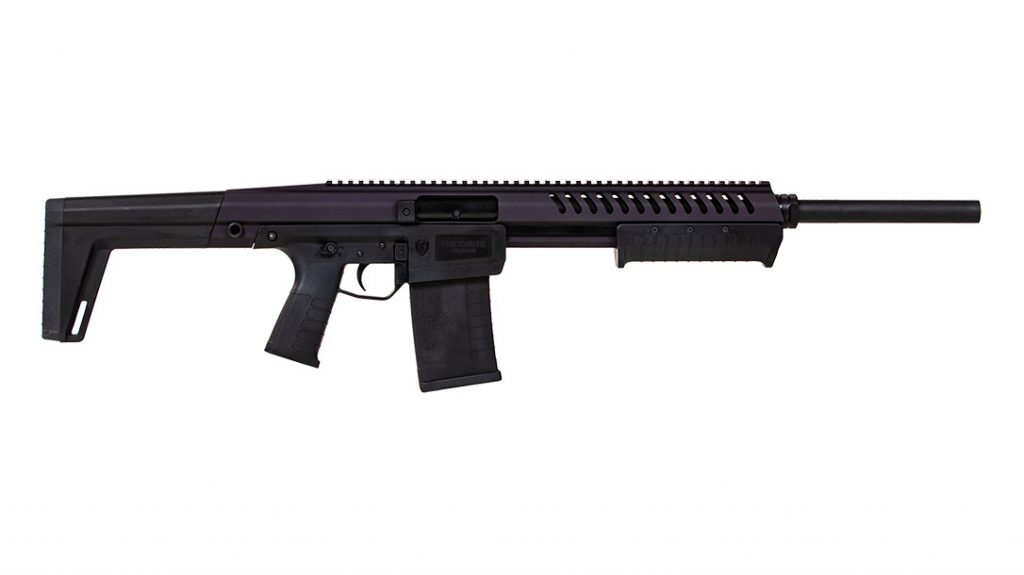
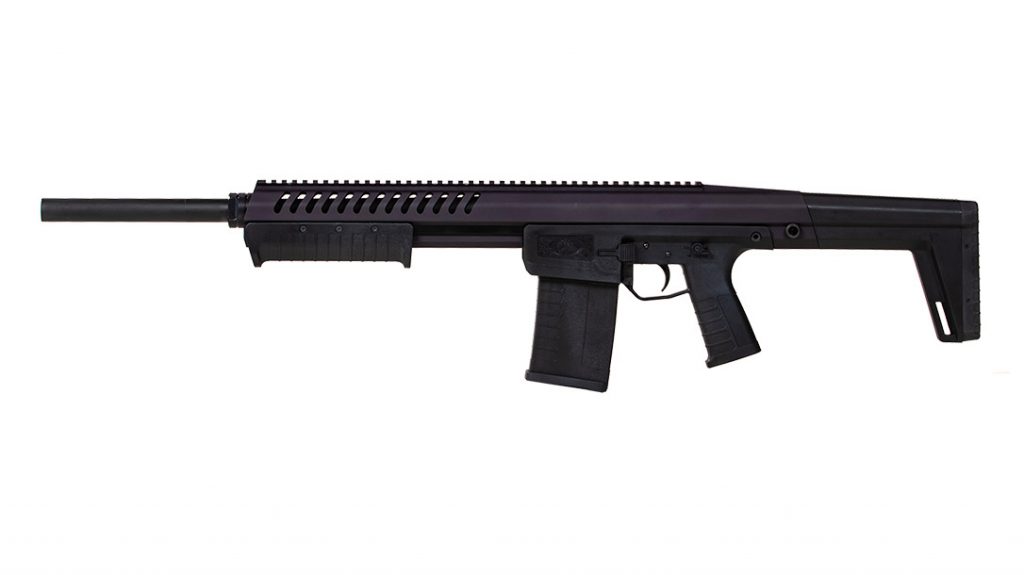
Advertisement — Continue Reading Below
McDonald also wanted to make something that was modular, much like the AR platform, so that users could similarly customize their pump shotguns to suit their needs.
“We wanted to make something modular so that it would be affordable for people to change things out and make it better as time goes on,” McDonald said. “If you look at the pump grip, you simply remove six screws and add a new injection-molded pump grip—and not too far down the road we’ll be offering alternatives for the stock pump grip, so that, for $30, you can make a major change to your shotgun.”
Other Goals for the Sentry 12 Shotgun
McDonald said he expected several new pump grips and stock options for the Sentry 12 to be available by early 2021, including a pump grip with an integrated gun light and a folding stock. The lower receiver, which includes the pistol grip, does not contain a serial number. This will allow for different versions in the future. McDonald says all the injection-molded parts take custom stippling very well.
Advertisement — Continue Reading Below
Other goals were to make the Sentry 12 lightweight, and easy to disassemble. “This was so it could be used for police and military applications, because, in the field, ounces are pounds and pounds are pain,” McDonald said, adding that the shotgun represents a big cost savings for smaller police departments. Instead of buying multiple color-coded shotguns to be used for lethal and less-lethal applications, they can buy Sentry 12s and color-coded magazines at a much lower cost, with the same end result.
Three Parts
This shotgun is extremely simple—simple to operate and simple in composition. I didn’t do a head count, but it may have the fewest parts of any pump gun on the market. It consists of three major parts.
The lower receiver is polymer and includes the grip and triggerguard all as one piece—it also houses the safety selector and the trigger, which, believe it or not, is a mil-spec-style AR trigger group. It’s an excellent trigger, especially since it’s a rifle trigger on a shotgun. I haven’t tried it, but I don’t see why it couldn’t be swapped out for any other AR mil-spec trigger or drop-in trigger assembly, if one so desired.
Advertisement — Continue Reading Below
The monolithic upper receiver is made of extruded aluminum and includes the barrel; a polymer, fixed buttstock; a generous toprail for irons, optics or both; and the handguard.
The third component is the simple bolt and carriage assembly, which includes the pump grip, which attaches to the dual action bars with six screws, three on each side. The slide runs along two channels cut right into the aluminum of the handguard.
All three components are held together by a single takedown pin. Remove it, take off the lower receiver, pop out the bolt and carriage and the gun is field-stripped and ready for cleaning. To remove the barrel, simply unscrew the hand-tight barrel nut. If you need a little help to break it loose, the nut fits perfectly between the action bars on the carriage, giving you plenty of leverage.
Advertisement — Continue Reading Below
And because of this modularity, some really interesting customization options are on the horizon for the Sentry 12, including new barrel options, that will make it one of the most versatile pump guns on the market.
Downrange
The Sentry 12 is instantly impressive right out of the box. The action is smoother and cleaner than that of any shotgun below competition grade that I’ve ever handled, especially brand new and without a drop of lube on it. The bolt carriage actually includes spring-loaded plungers that assist with opening the bolt and positively locking it up. When racking it at full speed, you don’t really notice it, only that the action is remarkably smooth and fast. But when you open the action to clear it, it’s definitely obvious.
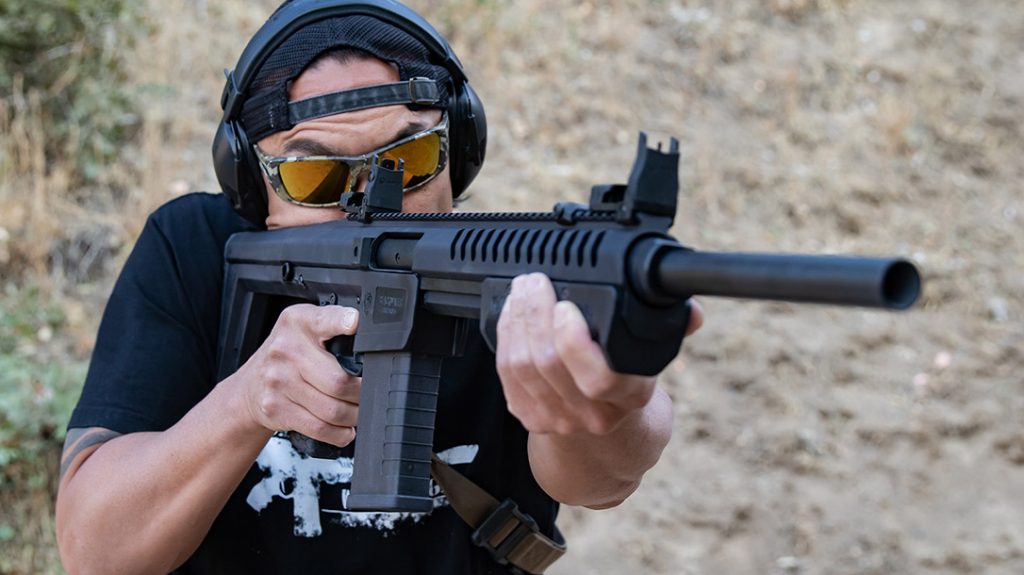
Advertisement — Continue Reading Below
The gun shoulders very naturally, and the in-line design makes it very comfortable. This is thanks to its svelte profile and dimensions, which McDonald credits to Troy Conant, his partner at Iron Horse Firearms and the president of Metropolis Design in Utah. It looks like an AR and it feels like an AR in the hands. The aluminum of the monolithic upper actually extends a few inches behind the pistol grip, making it very well balanced without the front-heavy feel of a lot of shotguns. It’s a remarkably not-bulky 12-gauge repeater and handles wonderfully.
Recoil and Controls
Though the included recoil pad on this sub-7-pound shotgun is quite thin, 2¾-inch self-defense and buckshot loads were easily tolerable, with a bit more felt recoil than expected, but less muzzle rise than my Mossberg 590, which I shot side by side with the Sentry 12. I won’t lie—the few 3-inch Magnum shells hurt a little through nothing but a T-shirt, and I wouldn’t want to fire too many. But there’s no reason you can’t attach an aftermarket recoil pad (it uses two screws, like most) or add a slip-on pad if you’re going to be shooting a lot-of 3-inchers for whatever reason. But here’s something I realized after a 200-round range session: the in-line design might send a bit more recoil into the shoulder, but almost none of it gets to your shooting hand through the pistol grip.
The controls are simple, intuitive and easy to use. They’re all ambidextrous, including an AR-style safety lever, a push-button mag release and a lever-style slide release located in front of the triggerguard that can be activated with the trigger finger, much like the slide release on a Kel-Tec KSG and KS7.
Advertisement — Continue Reading Below
I experienced no malfunctions of any kind with the Sentry 12 with any ammo I ran through it and discovered it’s impossible to short-stroke this gun.
Solid Introduction
The polymer magazines, also designed by Conant, are exceptional. They were very easy to load and fed flawlessly throughout my range test with high- and low-brass shells. The same mags work for 2¾- and 3-inch shells, and they fit into expandable AR-10 magazine pouches quite easily.
Right now, the mags are only available with a five-round capacity, but extensions for the five-rounders will soon be available and an eight-round version is also on the way. Most tactical pump guns have capacities between 5+1 and 8+1, depending on barrel length, so the Sentry 12 is right on par. Plus, 12-gauge mags with capacities higher than eight rounds are bulky, heavy, and too cumbersome to be practical.
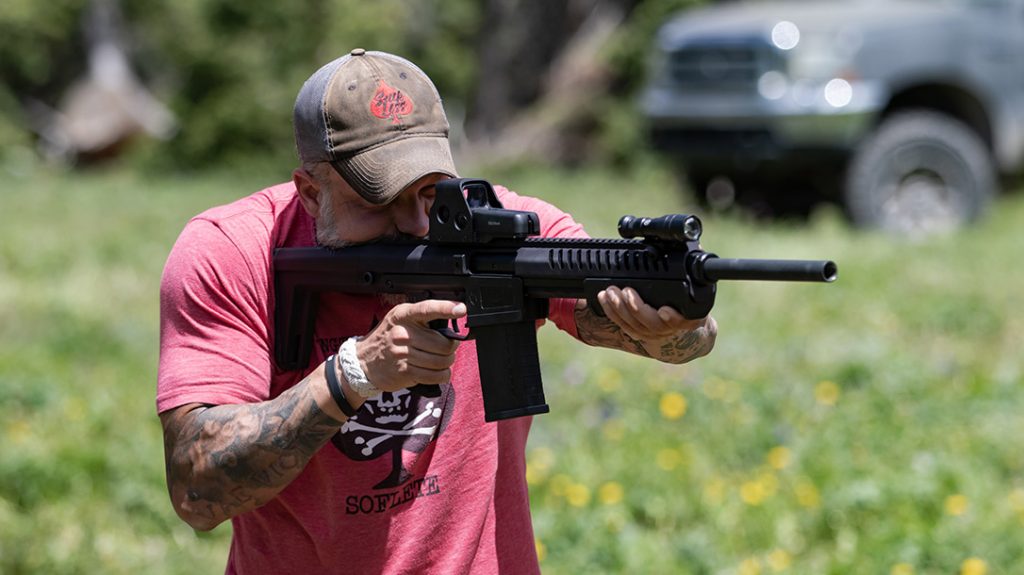
The Sentry 12, in many ways, is pretty minimalist. There’s no muzzle device, no choke system (the smoothbore barrel has no choke), and no extraneous features of any kind. This keeps costs low on the introductory model and sets a base for a possible future full line of shotguns and interchangeable parts.
The only thing I wish this first Sentry 12 model had was either a stock adjustable for length of pull, or some included spacers, because it’s just a tiny bit too short for me—and that’s a really small gripe that’s solvable with a thicker recoil pad.
Final Notes
The Sentry 12 is not a gimmick. It isn’t a plastic-y-feeling claptrap of just-better-than-3D-printed parts or some overcomplicated effort to make it something it shouldn’t be.
It’s a reliable shotgun with four years of designing, prototyping, testing and user feedback behind it. It’s innovative in a very satisfyingly simple way. I hazard to say it’s everything I ever wanted out of a pump shotgun, and I didn’t even know it. And an ever-expanding array of add-ons and components already has me imagining the kind of Sentry 12 I want to build. I want to shoot clays with this thing, and I want to tag a turkey with it. I would also not hesitate to make this shotgun my go-to home-defense shotgun as is.
Don’t let its looks or its use of polymers fool you—this is a wonderfully designed, extremely well-built firearm that shoulders well, shoots great and would make a more-than-ideal home-defense shotgun that’s extremely easy and fast to load and reload, easy for practically anyone to use and simple to unload and make safe.
The Sentry 12 is here to stay. To find out more visit IronHorseFirearms.com
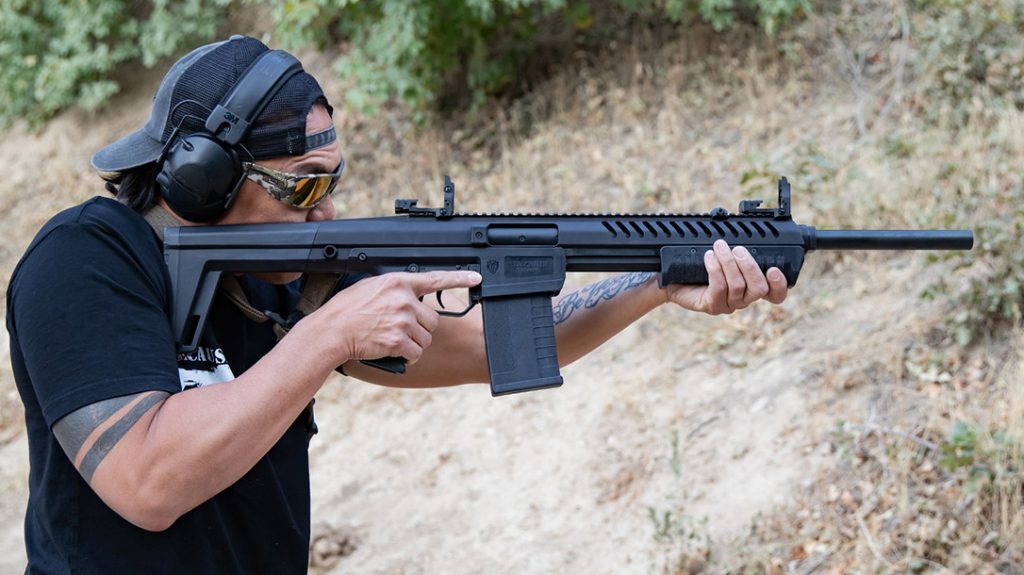
Iron Horse Sentry 12 Shotgun Specs
Gauge: 12
Barrel: 18.5 inches
Overall Length: 36 inches
Weight: 6.5 pounds (empty)
Stocks: Polymer
Sights: None
Action: Pump
Finish: Nitride-coated
Capacity: 5+1
MSRP: $899
This article was originally published in the Personal Defense World February/March 2021 issue. Subscription is available in print and digital editions at OutdoorGroupStore.com. Or call 1-800-284-5668, or email subscriptions@athlonmediagroup.com.
